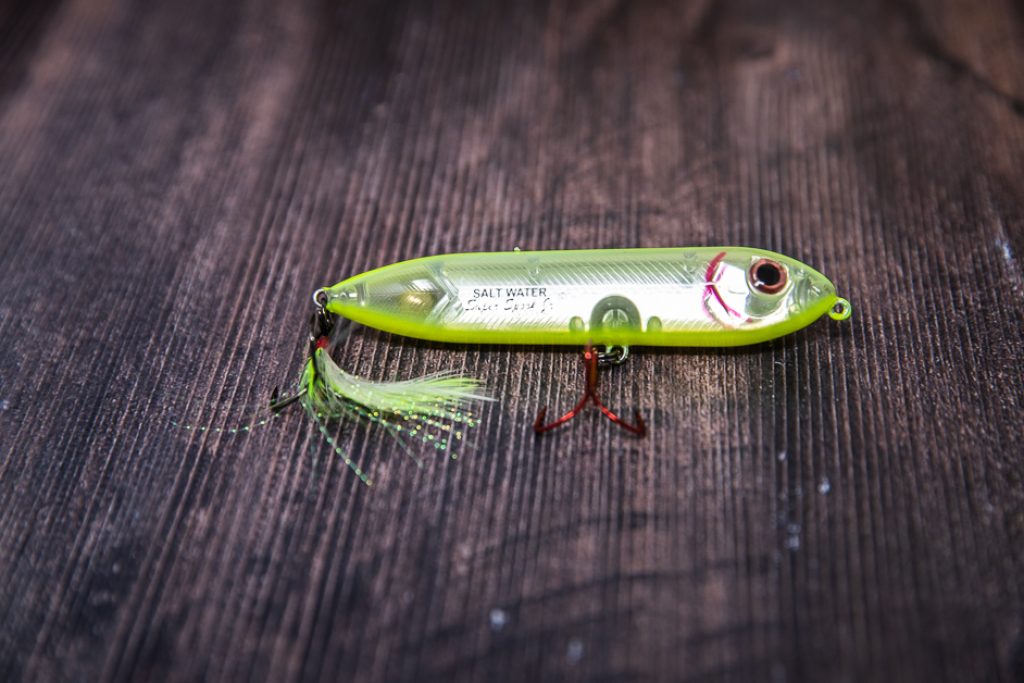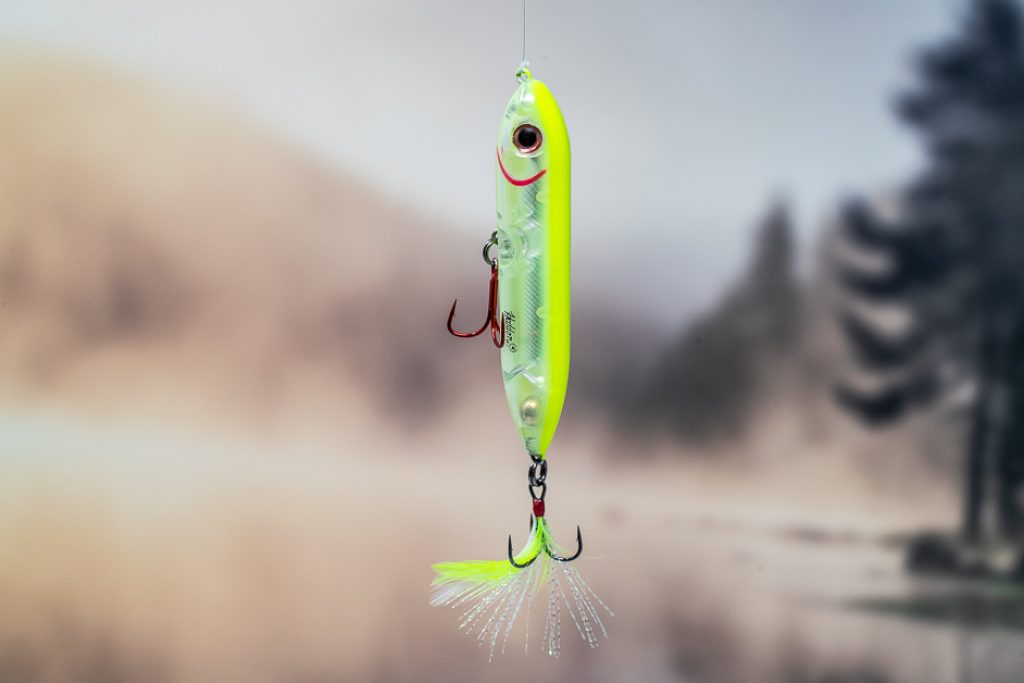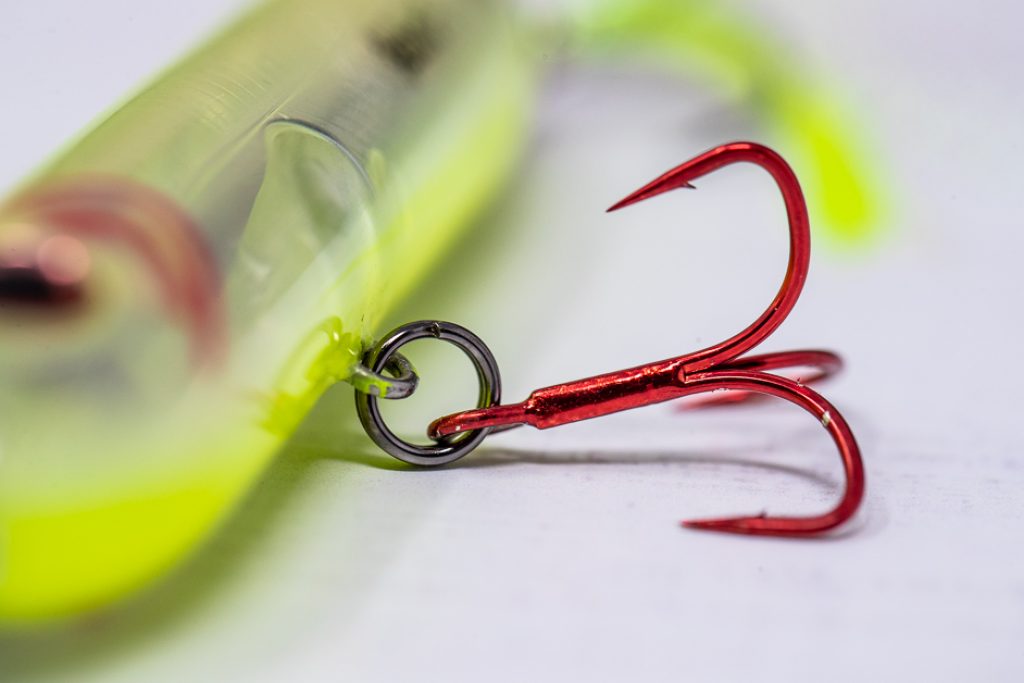Walking bait are the go-to option for fishing bass in most situations. From spring all the way to late fall, bass are usually willing to break the surface of the water to catch their prey. This long period is the perfect opportunity to use walking baits as they’re designed to sit on the surface of the water. So what else should you know about these popular baits?
What is a Walking Bait?
Let’s take a deeper look at what walking baits actually are. The term “walking” comes from the side-to-side surface action that is used with these baits. This action can also be referred to as “walking the dog”. Walking baits are usually longer and slimmer than other baits. They’re made from hard plastic, but can even be made from wood in some cases. They often come with some kind of audible addition as well, such as a small rattle or knocker. This is to generate a bit of sound that attracts bass to the bait.
Walking baits are sometimes known as just “walkers” as well. If you hear either term, know that they are interchangeable. Walking baits are usually between 3 inches to 6 inches long, and they usually have up to two treble hooks that are fixed onto the belly or end of the tail. You might occasionally find specialized topwater walking baits that are even larger than 6 inches, but these are generally only used in specific circumstances.
You’ll also find spinoffs of walking baits that incorporate various different add-ons. For example, some might have a mouth that spits, or it might create a minor popping action to add a bit of extra noise. Since there are so many different walking baits, you’ll want to try a bunch of them to see what works best for your style of fishing and the waters that you fish in. There is usually a bit of overlap with other categories of bass baits as well, so it can be a little confusing to identify a walking bait just from its appearance.
In short, walking baits are all about creating a lot of attention on the water. Whether it’s through disrupting the surface of the water or creating a lot of noise, they’re baits that will attract many basses as soon as it lands in the water. This makes it ideal for a number of fishing conditions, especially if you want to rattle the bass and bring them out of hiding. While walking baits do take a bit of time to get used to, you’ll be glad to know that they’re effective across three entire seasons, giving you plenty of time to get accustomed to them.
What’s the best walking bait setup for bass fishing?
A huge part of walking bait setups is the walking bait itself. Since there are lots of different options to choose from, we’ve listed a couple of great options at the end of this post. For now, we’ll be looking at the line, reel, and rod choices.
For a line, there are people that prefer braided lines and others that use mono lines. They’re both effective choices and there’s some personal preference involved. However, the go-to option will certainly be 30 – 50 lb braid because it casts very far, doesn’t stretch as much, and floats on the water. This is perfect if the bass fish around you are fairly large, but you can also use it in situations where there’s a lot of cover. In addition, if you find that your braids are getting caught on the front treble, you can use around a foot or two of 15 – 30lb monofilament leader. This can also be a good idea for bass that are weary of your line.
For reels, you generally want a 7:1 or 8:1 gear ratio and a good amount of line capacity when using walking baits. Line capacity is the biggest factor when it comes to effectively using a walking bait, but you also want to be able to reel it in quickly after a long cast.
Lastly, for rods, you should aim for something with a medium to medium-heavy action. You want to be able to launch your walking bait, so a longer rod will give you more leverage for a big cast. However, shorter rods are perfectly fine if you’re aiming for specific pieces of cover.
How do you fish using walking baits?
The key to effectively using walking baits for bass fishing is to build a rhythm by controlling the line slack and reeling it in. You leave a bit of slack in the line between the tip of your rod and the bait, then you keep the rod pointed down and pull up to snap the slack. Avoid keeping the line tight because this will pull the bait too far. Instead, release the slack after each twitch, allowing the bait to turn. Repeat this process so that it turns the bait in the other direction.
The goal here is to create a consistent rhythm where you’re controlling the bait in a side-to-side motion. As you get more accustomed to walking baits, you’ll be able to “walk” the bait without reeling in too much. This is perfect for when you’ve cast into an area with a lot of cover. This allows you to keep the bait in the strike zone for a longer period. If you notice that a bass has tried to strike at your bait but missed, you can slow down your walking to give them another chance. You can also try pausing your bait in place instead, but don’t leave it in place for too long.
Lastly, make sure you pick a walking bait that is the right color. Make sure you match the color of your walking bait to the local forage, but you may also want to use transparent or clear patterns if the waters are clear. Try different things based on your local fishing conditions and try and build a tackle box of different walking baits to see what works best for you.
When should you use walking baits?
Walking baits are excellent at disrupting the water and getting attention. For this reason, you’ll want to try and use walking baits for calm waters. If you’re looking for the perfect place to fish using walking baits, then it really depends on your style of fishing. Walking baits are great in areas with a lot of cover, but you can also consider fishing aggressively by aiming for dock structures and other obstructions.
For seasons, spring to late fall is usually the best time to try a walking bait. However, do keep in mind that these are just recommendations and it’s difficult to know the best conditions to use walking baits until you go out onto the water and try things out.
The best walking baits available
Heddon Super Spook Topwater Fishing Lure for Saltwater and Freshwater
With a slender profile, two sharp hooks, and durable construction, this Heddon super spook is a great walking bait option that is both affordable and long-lasting. It’s perfect when used with a walking technique and comes in fantastic designs that will expand your tackle collection.
Heddon Zara Spook Topwater Fishing Lure – Legendary Walk-The-Dog Lure
The Zara Spook is a well-known walking bait that has a double hook design which is perfect for catching stubborn and larger bass. It’s available in many different colors and styles as well, so you’ll have no trouble building a collection of walking baits for any kind of situation.
Strike King KVD Sexy Dawg
The Strike King is a premium walking bait that has free-floating rattles and three hooks as opposed to the more common two hook design you’ll see. At 4.5 inches, it’s certainly not the biggest walking bait but it’s a great size that will attract plenty of bass. There are many unique designs to pick from and they’re a tried-and-tested bait that will deliver excellent results.
RUNCL Popper Bait, Walking Bait 4/5in
The RUNCL walking bait offers premium razor-sharp hook tips and a rear-weight design that allows the bait to fly through the air even during windy conditions. This makes it a great choice when water conditions are a little rough. You’ll find lots of unique designs and colors, and the overall quality of this walking bait is surprisingly high for the price.
Dr.Fish Topwater Walking Bait
If you’re looking for an affordable option to try out walking baits, then this Dr. Fish topwater walking bait is the perfect option. It has strong hybrid hooks, a weight transfer system that makes it easier to walk on the water, and a reflective body to make it more attractive and cause more commotion when it lands in the water.





















